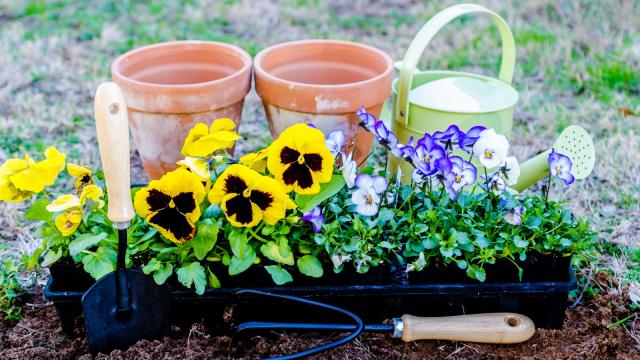It’s the first day of glorious spring here in Australia, and we’re wasting no time getting ready for spring planting season. Here’s how to thaw your garden out of its winter funk ready for a fantastic season of blooms.
Take Stock
If your garden has been lying fallow since Autumn, your first order of business is to give the area a thorough inspection. Check any raised beds for bowing sides and look over your fences and trellises for stake rot or broken cross-members. Also take stock of the overwinter weed growth — and whether you’ll need a trowel or a rototiller to remove them — as well as the condition of any ornamentals or perennials you may have. Most importantly, carefully inspect the condition of your soil. More on this in just a bit, but first, it’s tool time.
Before you start digging post holes or going medieval on invading weeds, make sure your tools are up to the task. Clean and sharpen anything with an edge — not just branch loppers and hedge clippers but hoes, shovels, and trowels as well. Give power tools like chainsaws, weed eaters, string trimmers, and lawnmowers a thorough cleaning and inspection. Now would also be a good time to drain and refill the petrol tank (if the tool has one) as fuel left idle for too long will foul.
These steps not only ensure that your tools keep their edge — thereby reducing the amount of cutting force required and extending the life of the equipment — but help reduce to disease transmission between cuttings as well. Viruses such as the Mosaic family can infect anything from Casava to Alfalfa and are spread via horizontal transmission — that is, by cutting an infected stem then using the same blade to cut another, uninfected one without first sterilising the blade.

Mend Fences
To repair bowing boards on raised planter beds — caused when the stakes rot away after spending all winter in wet soil — simply dig out the soil behind the bowing board, push it back into alignment, and drive a new stake. Make sure it’s tilted in towards the bed a little, for added strength, and fasten it to the board with screws or nails.
Similarly, both trellis and fence posts can (and will) eventually rot away. After the spring rains have subsided and the water table has dropped again — plunking a new post into sopping wet soil will only cause it to rot as well — dig out the old post and carefully drive a new one into its place, paying attention to not damage any nearby roots.

Exterminate!
Before you start amending your soil, you’ll first want to clear any fallen leaves, branches, dead plants, and other compostable debris from its surface, then thoroughly weed the plot. If you only have a few rogue weeds pushing up, the Fiskars Uproot weed assassin is immensely helpful.
However, if your plot has been fully invaded by weeds, break out the rototiller, turn the top layer soil over, and sift out the plant matter. Additionally, mats of runner grass can easily be removed with a flat trowel or spade: simply cut a straight line along one edge of the mat then gently lift the mat while you slice horizontally through the roots as they become exposed.
Turning over the soil will also likely churn up a number of hibernating pests so you might as well rid your garden of them now. Check any perennials for slugs, snails, or aphids, treating any infestations you find.
As Lifehacker explains, spreading spent coffee grounds throughout the garden will both deter slugs while giving the soil an extra kick of nitrogen. You can also attract and trap the nmonopods in a hollowed-out orange rind. And while ladybugs are famous aphid hunters, don’t waste your money buying a bag of the predatory insects — there’s no guarantee that they won’t simply fly away.

Work that Soil
The best way to ensure a terrible harvest is to plant your spring crops too early, before the soil has had sufficient time to dry out. Seedling roots require well-aerated soil to grow efficiently, but soil compressed by water or ice saturation smothers them. What’s more, compressed soil can harden into large clods when it dries, which is equally detrimental to growth because it creates large air gaps that starve roots of nutrients.
To ensure that your plot is dry enough to plant in, grab a fistful of soil and press it into a ball between your hands. If it remains a single pliable mass, or only breaks into large chunks when dropped from waist height, it’s too wet. Sufficiently dry soil should break apart into loose soil from that distance.
If last year’s bumper crop has depleted your soil’s nutrient content, you’ll need to amend it before planting again. The process of amending soil involves adding materials in order to augment or modify the soil’s physical characteristics. Sandy soils, for example, need amendments that increase its water and nutrient holding capacity, while clay soils need amendments that improve its aeration and porosity. Pick up a soil test kit from your local home improvement centre to determine the plot’s pH balance. This, in addition to the type of soil you have, determines the type of amenity you’ll need. Make sure you bring a small bag of soil with you when you go to buy the kit and save yourself the return trip to buy the necessary amendments. Once you do have all the amendments you need, it’s just a matter of digging up the top 6 to 12 inches of existing soil, thoroughly mixing the materials in, and then raking them level.
Now that your garden soil is packed with nutrients, it’s just a matter of deciding which spring crops you want to plant. Swiss chard, beets, lettuce, peas, and radishes are all solid choices and can be planted in an afternoon. Next week, we’ll be tackling the task of bringing your lawn out of its winter hibernation.
[Earth Easy – Dummies – Thompson Morgan – Organic Gardening – Colorado State University]
Images: Danny E Hooks, Iakov Filimonov, Protasov AN, Apples Eyes Studio
